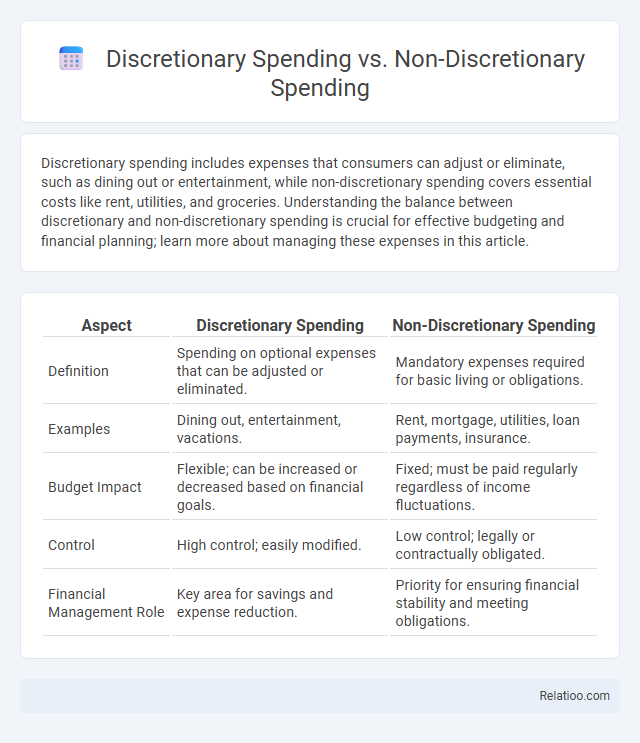Discretionary spending includes expenses that consumers can adjust or eliminate, such as dining out or entertainment, while non-discretionary spending covers essential costs like rent, utilities, and groceries. Understanding the balance between discretionary and non-discretionary spending is crucial for effective budgeting and financial planning; learn more about managing these expenses in this article.
Table of Comparison
| Aspect | Discretionary Spending | Non-Discretionary Spending |
|---|---|---|
| Definition | Spending on optional expenses that can be adjusted or eliminated. | Mandatory expenses required for basic living or obligations. |
| Examples | Dining out, entertainment, vacations. | Rent, mortgage, utilities, loan payments, insurance. |
| Budget Impact | Flexible; can be increased or decreased based on financial goals. | Fixed; must be paid regularly regardless of income fluctuations. |
| Control | High control; easily modified. | Low control; legally or contractually obligated. |
| Financial Management Role | Key area for savings and expense reduction. | Priority for ensuring financial stability and meeting obligations. |
Understanding Discretionary vs Non-Discretionary Spending
Discretionary spending refers to expenses that are optional and can be adjusted or eliminated based on financial decisions, such as entertainment, dining out, and vacations. Non-discretionary spending includes essential costs that are necessary for basic living and cannot be easily changed, like rent, utilities, and groceries. Understanding the difference between discretionary versus non-discretionary spending helps individuals create effective budgets, manage cash flow, and prioritize financial goals.
Key Characteristics of Discretionary Expenses
Discretionary spending refers to expenses that are non-essential and can be adjusted or eliminated based on financial priorities, such as entertainment, dining out, and luxury purchases. Non-discretionary spending includes fixed, necessary costs like housing, utilities, and groceries, which are critical for daily living and typically have limited flexibility. Key characteristics of discretionary expenses include their variable nature, subjective importance, and their role as a financial buffer for savings or debt repayment during tighter budget periods.
What Qualifies as Non-Discretionary Spending?
Non-discretionary spending includes essential expenses that you must pay regularly, such as rent or mortgage, utilities, groceries, insurance premiums, and loan repayments. This spending is mandatory and typically fixed, reflecting your financial obligations that cannot be easily adjusted or eliminated. Understanding the difference between non-discretionary and discretionary spending helps you manage your budget by identifying which costs are essential and which expenses can be reduced or postponed.
Common Examples of Discretionary Spending
Common examples of discretionary spending include entertainment, dining out, vacations, and luxury items, which are expenses you can adjust based on your budget. Non-discretionary spending covers essential costs such as rent, utilities, groceries, and healthcare that must be paid regularly. Understanding the difference helps you prioritize your financial goals by distinguishing flexible expenses from necessary commitments.
Essential Examples of Non-Discretionary Expenses
Non-discretionary spending includes essential expenses such as rent or mortgage payments, utility bills, groceries, and healthcare costs, which are necessary for basic living and cannot be easily reduced. Discretionary spending refers to non-essential expenses like dining out, entertainment, and luxury purchases, which individuals can adjust based on their financial situation. Understanding the distinction helps in budget planning, ensuring priority is given to non-discretionary expenses to maintain financial stability.
How to Identify Your Spending Categories
To identify your spending categories accurately, start by tracking all monthly expenses and sorting them into discretionary and non-discretionary spending. Discretionary spending includes non-essential items such as entertainment, dining out, and hobbies, while non-discretionary spending covers essential costs like rent, utilities, and groceries. Categorizing your spending this way allows you to create a balanced budget and make informed decisions about where your money goes.
Impact of Discretionary Spending on Personal Budgets
Discretionary spending, unlike non-discretionary spending which covers essential expenses such as rent and utilities, includes non-essential purchases like entertainment, dining out, and vacations. Your ability to control discretionary spending directly impacts your personal budget flexibility and savings potential, allowing you to adjust spending habits in response to financial goals or unexpected expenses. Managing discretionary spending effectively helps maintain financial stability and achieve long-term financial objectives.
Managing Non-Discretionary Costs Effectively
Managing non-discretionary spending, which includes essential expenses like rent, utilities, and loan payments, requires careful budgeting to ensure financial stability. Prioritizing these fixed costs prevents debt accumulation and maintains creditworthiness. Effective management of non-discretionary expenses creates more flexibility for discretionary spending on variable items such as dining out, entertainment, and travel.
Strategies to Balance Discretionary and Non-Discretionary Spending
Strategies to balance discretionary and non-discretionary spending involve prioritizing essential expenses like housing, utilities, and groceries before allocating funds to non-essential items such as entertainment or dining out. You can create a detailed budget that sets clear limits for discretionary spending while ensuring that non-discretionary costs are fully covered. Regularly reviewing and adjusting your budget helps maintain financial stability and prevents overspending in flexible categories.
Importance of Differentiating Spending Types for Financial Planning
Understanding the differences between discretionary spending, non-discretionary spending, and essential expenses is crucial for effective financial planning. Discretionary spending includes non-essential purchases, while non-discretionary spending covers mandatory costs like rent, utilities, and debt payments that must be prioritized to maintain financial stability. By accurately categorizing Your expenses, You can create a realistic budget, control cash flow, and make informed decisions about saving and investing.

Infographic: Discretionary Spending vs Non-Discretionary Spending
 relatioo.com
relatioo.com